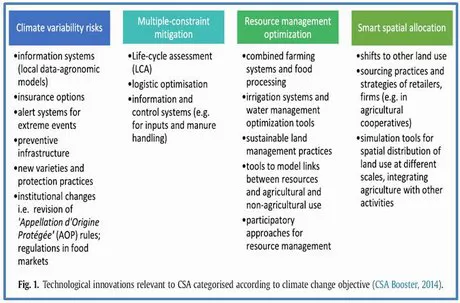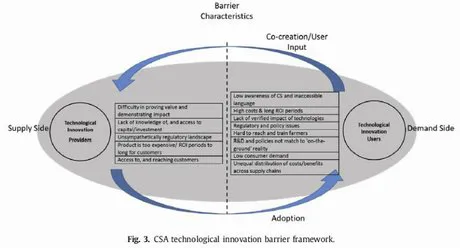 Climate-smart Agriculture (CSA) is highlighted as key response to the new agriculture challenges of climate change, greenhouse-gas (GHG) emission reductions, and increasing world population. Global food systems contribute between 19% and 29% of global GHG emissions and under current projections, in order to feed the global population in 2050, food production must increase by 70%.
Climate-smart Agriculture (CSA) is highlighted as key response to the new agriculture challenges of climate change, greenhouse-gas (GHG) emission reductions, and increasing world population. Global food systems contribute between 19% and 29% of global GHG emissions and under current projections, in order to feed the global population in 2050, food production must increase by 70%.Scientists at Wageningen University have identified key socio-economic barriers, in terms of supply and demand, that inhibit the adoption and diffusion of CSA technological innovations in the EU.

Click here to enlarge.
To achieve this aim, a theoretical framework is designed based on a literature review of socio-economic barriers effecting CSA adoption and diffusion. This framework is explored with data from semi-structured interviews with CSA technology providers and members of agricultural supply chains, such as farmers associations and consumer goods producers (the end-users of the technology).
Data was collected on the barriers they experienced, with interviews conducted in four EU countries during a European project funded by Climate KIC, called the CSA Booster. This project aimed at exploring barriers and bottlenecks to CSA technological innovation adoption and diffusion, and at identifying services which could enhance and secure the adoption of CSA technologies in the EU agricultural sector. This project included partners in the Netherlands, France, Italy and Switzerland. Data was thematically coded and categorised to identify key barrier typologies.
Scientists summarise that whilst some of the barriers identified through this study are found within the literature, several aspects may be more novel to the context of CSA; specifically, these include the difficulties of technology providers in demonstrating and proving the value of their technological innovations, a lack of access to and knowledge of capital and finance (although this relates somewhat to cost barriers) and difficulties in accessing and reaching customers.
Click here for an overview of the barriers.
By identifying barriers to CSA technological innovation adoption – scientists explain - this study has provided a first assessment of the context of CSA technological innovations in EU countries and has illustrated the key barriers that need to be overcome in climate proofing European agriculture systems, according to our sample of potential users and technological innovation providers. In turn, this allowed a discussion of provisional activities and policy measures that may need to be enacted in order to enhance and boost technological innovation for CSA in the Netherlands, France, Italy and Switzerland; these results may also be relevant to other EU countries, however further research will be required to for this to be confirmed.
A key result of this work identified that barriers exist on both the demand (users) and supply (technology providers) sides, indicating that traditional supply based innovation policies alone will be unlikely to lead to sufficient levels of technological innovation adoption to aid the agricultural sectors transition to the practice of CSA.

Click here to enlarge the figure.
Results of the work are available online from June 20 at: http://www.sciencedirect.com/science/article/pii/S0959652615007738
Source: Long T.B., Blok V., Coninx I., ‘Barriers to the adoption and diffusion of technological innovations for climate-smart agriculture in Europe: evidence from the Netherlands, France, Switzerland and Italy’, 2015, Journal of Cleaner Production, http://dx.doi.org/10.1016/j.jclepro.2015.06.044
Contacts:
Thomas B. Long
Wageningen University
The Netherlands
Email: tomblong9@aol.com
